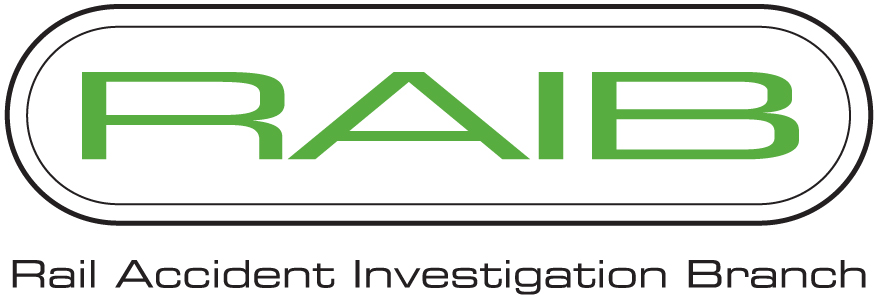Annual Report for 2024
Published 15 May 2025
Our Purpose: We independently investigate accidents to improve railway safety and inform the industry and the public.
1. Chief Inspector’s review of 2024
2024 was a year of uncertainty and change for the British mainline rail industry. However, while the structure of the industry is changing, RAIB’s purpose remains unchanged. That is, to investigate accidents to improve railway safety, and inform the industry and the public. The principles of safety investigations apply equally to varied organisational models and RAIB successfully investigates accidents and incidents that occur throughout diverse sectors of the industry, including the mainline railways in Great Britain and Northern Ireland, metros, tramways and heritage railways.
It was also, in some ways, another year of change for RAIB. The effects of a number of retirements in 2022 have receded and five new inspectors completed their training and started undertaking investigations. However, we, in common with many other government organisations, have been required to cut headcount: in our case by 8%. This will present challenges, mainly relating to the resilience of our operational support functions, but we continue to always aim to maintain our level of operation and the quality of investigations.
The year was marked by the head-on collision of two passenger trains at Talerddig. Tragically, one passenger died, and four others were seriously injured. This accident is currently under investigation and this is described in Interim Report 01/2025.
The RAIB report into the major accident at Carmont in August 2020 was published in March 2022. Given the accident’s severity, we have separately tabulated the status of the twenty recommendations in section 8. In accordance with our legal framework, this information was provided to RAIB by the Office of Rail and Road (ORR). A lot of work has been undertaken and progress made in closing the recommendations in the intervening years. However, eight remain open, indicating that there is still work to do.
Rail and tram travel in the UK is very safe and accidents such as Carmont and Talerddig are thankfully rare. However, they act as a stark reminder that risks involved in railway operation are ever-present, and of the consequent need for constant learning and vigilance.
This report summarises the work of the branch in 2024. Six main themes have run through our investigative activity and these are outlined below.
1.1 Track worker safety
Network Rail has reduced the amount of track work carried out on or close to open lines using unassisted lookouts as protection, to almost zero. This has had the desired effect of reducing the number of near misses between moving trains and track workers. The industry reports that there are now around 60% fewer track worker near misses than in 2018/19. However, the downward trend has flattened and some very near misses still occur.
The move away from unassisted lookout working means that more track maintenance tasks are being undertaken by staff working on lines that are blocked to traffic. In such systems, the understanding of exactly where a track worker or group is, which lines are blocked, the limits of the designated safe working area and the times the blocks are in place for, are critical. Proper planning of the safe system of work (SSoW) and accurate briefings, followed by the continuous presence of the controller of site safety with the work group, to both set up and ensure adherence to the SSoW, are also vital.
RAIB published three safety digests in 2024 relating to track worker near misses: Fishguard (safety digest 01/2024); Euxton Junction (safety digest 05/2024); and Littlehempston (safety digest 07/2024). An investigation into a near miss at Chiltern Green (report 06/2025) and a safety digest relating to a near miss at Morton Junction (safety digest 02/2025) were ongoing at the end of the year.
These digests and the investigation illustrate what can go wrong and that there is still work to do to make working on the track safer, which Network Rail is aware of and undertaking. Like Network Rail, London Underground is also rightly putting considerable focus on track worker safety.
1.2 Platform safety
Previous RAIB annual reports have discussed at length the safety of people getting on and off trains and explained the issues around people being trapped in doors and dragged. These incidents and accidents have occurred on mainline railways, metros and tramways. The lessons often relate to public education, the efficacy of the final safety check performed by the person responsible for dispatch, the technology used to aid that person and understanding levels of risk at specific platforms. In 2024, we published one report covering two trap and drag accidents on the London Underground Northern line: one at Archway and one at Chalk Farm (report 06/2024), and a safety digest covering an incident at Enfield (safety digest 09/2024). We also started an investigation into a trap and drag incident at Ealing Broadway on the Elizabeth Line that is currently ongoing.
The unsafe movement of a train at a Styal station platform (report 07/2024), the self-evacuation by passengers at Clapham Common (report 03/2024) and a passenger sustaining fatal injuries after falling from a platform and being run over by trains at Stratford (report 01/2025) may seem different from the trap and drag incidents referred to earlier. However, what these accidents have in common was that the staff found it difficult to quickly move from a state of relatively low mental load to the high-performing state required when undertaking safety-critical dispatch tasks or dealing with out-of-course events. As railways continue to automate elements of operation to enhance efficiency, it is important to carefully consider the impact this may have on staff performing the remaining tasks that still require human oversight.
A different kind of accident occurred at Banbury when an occupied pram rolled into contact with the side of a moving train (safety digest 10/2024) and an infant was injured. This was, in part, a result of an imperceptible platform slope towards the tracks. In common with some of the other accidents, there was, however, also a lack of understanding by the station operator of the risk at specific platforms.
1.3 Asset integrity
In February 2023, a passenger train struck brick rubble on the single line at Yarnton, between Oxford and Charlbury, at around 58 mph (93 km/h). The train was damaged but did not derail (report 01/2024). The rubble had fallen onto the track from a failed wing wall, which formed part of a bridge carrying a local road over the railway. The wing wall had a hidden defect which was not found during inspection and maintenance, as the wall was already known to be in poor condition. The wall collapsed when it was no longer able to carry the load imposed by the embankment it was supporting.
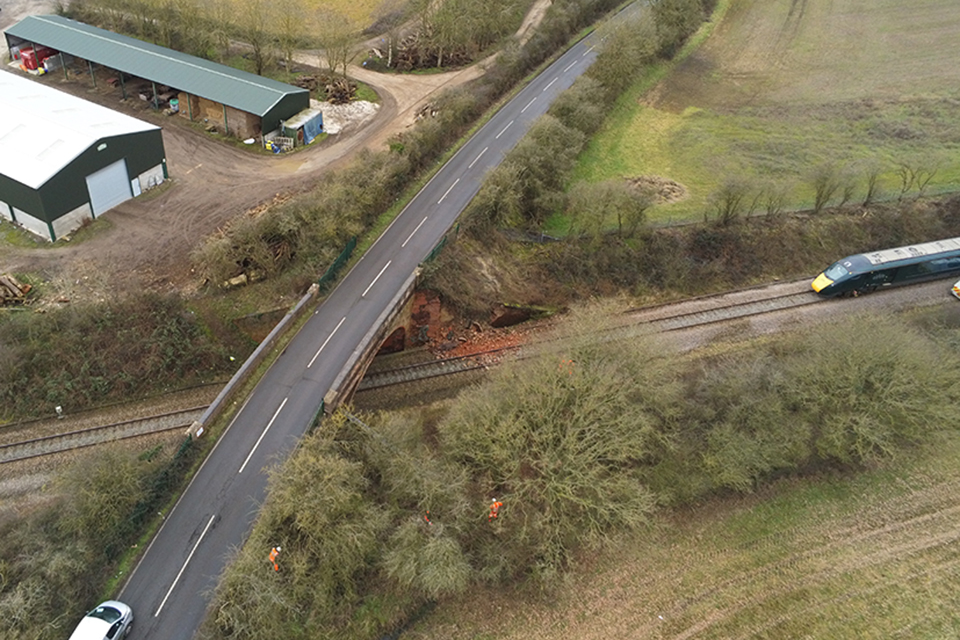
Yarnton
Around a year later, at Grange-over-Sands, a passenger train derailed when part of the embankment supporting the track on which it was travelling collapsed (report 02/2025). The embankment was over 170 years old and was not constructed as originally specified. The surrounding area had been subject to long-term flooding problems, exacerbated by increasing levels of rainfall. After many years of these problems not being solved by the railway and a number of external parties involved, a temporary pipe was installed in the ballast close to the surface, through which water was pumped from the landward to the seaward side of the embankment. In March 2024, the pipe was punctured during track maintenance activities, allowing pressurised water into the embankment core. Although the pipe damage was reported, action was not then taken to avoid part of the embankment collapsing under the train, 3 days later.
When the report was published I wrote,
Derailments of passenger trains are thankfully rare. The elements that came together in March 2024 and led to the derailment of a passenger train at Grange-over-Sands include a number that have been seen in previous RAIB investigations. Ageing Victorian infrastructure, increasing rainfall, a known flood water management problem which multiple parties with their naturally differing interests had not fully resolved over years, a ‘quick-fix’ to manage a risk effectively becoming the permanent solution, and ineffective communication, all played a part in this derailment. Given that the first two elements are inevitable, the importance of avoiding the others is ever more vital as time passes and the climate changes, if such derailments are to remain a rarity.
UK railway assets are often old and have no reliably documented history. This can create considerable difficulty for Network Rail and other infrastructure managers, which, at the moment, is being compounded by climate change, particularly increased rainfall. In some instances, further difficulty in implementing solutions can be introduced by the involvement of outside parties, over whom the railway does not have direct control, but whose co-operation is nevertheless required.
As with track worker and platform safety, asset integrity has been a theme in recent RAIB annual reports. The railway is putting a lot of effort into understanding and managing the risk associated with climate change and its effect on the integrity of railway assets. The two incidents described illustrate why that continues to be essential.
1.4 Safety of the line after engineering work
In 2018, RAIB issued urgent safety advice (USA) titled, ‘Safety of the line after engineering work’ (USA 02/2018). This was in response to a number of incidents in the previous 4 years which resulted in lines being reopened to traffic in an unsafe condition after engineering works. There have been similar incidents between 2018 and 2024, most notably in October 2021, when a passenger train travelling at 123 mph (198 km/h) struck a hand trolley on the track near Challow, Oxfordshire (report 11/2022).
In 2024, RAIB published two safety digests, Highdyke Junction (safety digest 02/2024) and Kings Langley (safety digest 06/2024), relating to trains striking parts of temporary access points, used to allow road-rail vehicles to access the track, that had been left behind after engineering work the night before. In both cases, issues with the planning and execution of the engineering works, as well as with the processes to check that the line was clear before being handed back for service, resulted in an unsafe situation.
In March 2024, a passenger train derailed at Walton-on-Thames after striking redundant rail left on the track after engineering works (report 04/2025). The issues behind it were similar to those that have been seen in earlier incidents.
Back in 2018, our urgent safety advice was that Network Rail should take urgent action to review the effectiveness of the steps it has already taken to address these risks, and to implement any additional measures required to ensure the safety of the line following engineering works. Network Rail has undertaken considerable work in the intervening period, but recent events illustrate that a significant level of risk remains.
1.5 Safe operation of plant in possessions
RAIB has investigated a number of accidents involving plant operated in possessions where work is carried out while the railway is closed to normal traffic.
At Strood (report 11/2024), an on-track machine driver was injured while coupling a multi-purpose vehicle (MPV) to a tamper on the High Speed 1 (HS1) line near Strood, in Kent. The tamper, which had been stationary, moved and struck the driver after a second MPV collided with the other end of it at a speed of about 20 km/h (12 mph). This second MPV was being driven towards the tamper with the intention of coupling all three vehicles together at the end of a night shift. The driver sustained injuries requiring hospital treatment. Although released from hospital the same day, it was 4 months before the driver was able to return to work due to the psychological distress resulting from the accident.
At Brading (report 12/2024), a road-rail vehicle, travelling in a work site, collided with a hand trolley being used by a work group on the Isle of Wight’s Island Line. As a result of the collision, two members of the track repair work group were injured when the trolley struck them on the legs, pushing them into bushes beside the track.
In February 2024, a track worker was struck and injured by a road-rail vehicle (RRV) while working in a possession on the Midland Main Line near Braybrooke in Northamptonshire (safety digest 04/2024). The track worker was walking along the track and directing the movement of another RRV on an adjacent line when they were struck. As a result of the accident, the track worker sustained a leg injury which required hospital treatment.
In May 2024, a track trolley ran away on a descending gradient towards a site of work and a team of track workers at North Rode (report 07/2025). The trolley came to a stop after it collided with equipment being used for moving rails within the site of work. The track workers had seen the runaway trolley approaching and moved clear of its path before the collision occurred. No one was injured by the accident. The trolley derailed in the collision, which also caused damage to it and to the rail-moving equipment that it struck.
While these accidents were varied in nature, and in some cases occurred on infrastructure being managed by different organisations, events involving moving plant and people always have the potential to cause serious harm. The number of incidents of this kind which RAIB has dealt with in 2024 is concerning.
1.6 Management of trees
The management of vegetation is vital for the safe operation of the railway. Trees can fall onto the track and be struck by trains, and vegetation can more generally affect the stability of structures and earthworks, foul running lines, block visibility of signals, and get too close to high voltage overhead electrification equipment. Fallen leaves can also reduce wheel-rail adhesion causing trains to have extended braking distances.
Leaf-induced low adhesion was a factor in the collision between two passenger trains at Salisbury Tunnel Junction (report 12/2023), behind which lay issues with vegetation management. While the accident at Talerddig is still under investigation, we know that low wheel-rail adhesion played a part, but to what extent that related to the management of trees is still being determined.
At both Broughty Ferry (report 13/2024) and Roudham Heath (report 03/2025), trees fell onto the track from land outside the railway and were struck by passenger trains at speed. In the first case, serious damage was caused to the train’s cab and the driver only escaped serious injury by crouching behind the driving seat. In the second accident, although no one was injured, a passenger train was nevertheless damaged and became derailed. These accidents illustrate the importance of external parties with trees close to the railway understanding the risks should their trees fall, and of Network Rail finding technological ways to monitor trees which are outside railway land, but which potentially may still pose a threat to safety. This is something which Network Rail is starting to do on some routes.
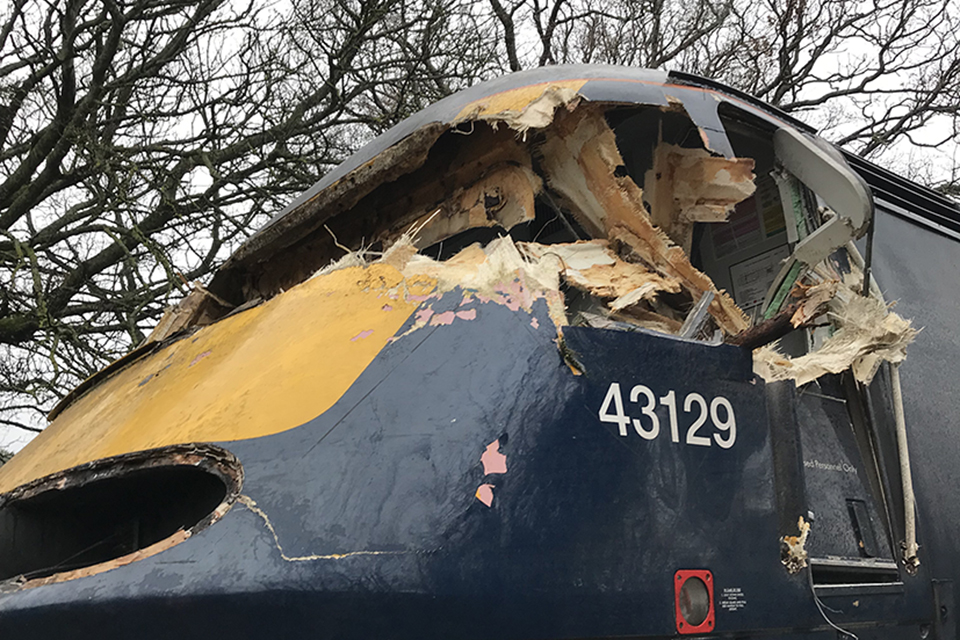
Broughty Ferry
1.7 Concluding thoughts
It has been almost universally accepted for many years that learning from accidents and incidents improves safety. UK health and safety law requires employers to learn lessons from accidents, and governments around the world have, and continue to, set up independent accident investigation bodies to investigate and learn from transport accidents and incidents.
When RAIB published the report into an overspeed at Spital Junction, Peterborough, in May 2023 (report 10/2024), I wrote,
An underlying factor behind this incident was that neither Network Rail nor the East Coast Main Line train operators effectively controlled the risk of overspeeding at Spital Junction both at the time the protecting signal’s operation was changed in 2014 and following the previous incident in 2022.
During the 2022 incident a train crossed the 30 mph limited junction at around 76 mph; a speed at which it is likely that some wheels lifted off the rails and close to a speed that could have caused the train to overturn. Thankfully a serious accident had been very narrowly avoided but thirteen months later, in this incident, the same junction was crossed at 66 mph in similar circumstances. This, once again, reinforces why learning from previous accidents and incidents and taking effective action in response to them is a vital means of improving safety and avoiding repeating mistakes of the past. The fact that the management of risks associated with an incident may be shared between one or more party does not alter this.
This lack, or loss, of learning can be seen in other areas of railway operation. For example, the moving train contacting the occupied pram at Banbury (safety digest 10/2024) has close parallels to accidents involving a wheelchair user falling from the platform onto the track at Southend Central station in August 2013 and an infant in a pushchair rolling onto the track at Whyteleafe station in September 2013 (report 17/2014).
Examples of not learning from accidents and incidents are not unique to the mainline railway. A possible underlying factor in the self-evacuation of passengers at Clapham Common station in May 2023 (report 03/2024) was that London Underground did not fully apply and retain learning from a previous similar incident at Holland Park station in August 2013 (report 16/2014).
Throughout the 200-year history of the railway, many of the big advances in safety have been driven by learning from accidents. While we have got much more sophisticated in managing risk over that time, the expectation that accidents will not be repeated remains as real and reasonable as ever.
There are a number of ways in which organisations seek to understand risk to decide how to allocate limited resources to maximise safety benefit. Developing risk models from large historic data sets, scrutinising data derived from safety assurance or inspection activities, and investigating accidents and incidents to a level that determines underlying management factors are examples of methods used in the railway industry. Each method looks at what may go wrong in a different way and, while there is often a large overlap in the conclusions drawn about where to focus resource, inevitably some differences will emerge. No method is perfect; each has strengths and weaknesses, so a balanced approach is key.
On 17 October 2005, RAIB started investigating railway accidents, making the 2024 Annual Report the twentieth to be published. By the end of 2024, we had deployed to accidents 752 times and published 419 full reports and 134 safety digests or bulletins. These included 1873 recommendations, and 700 safety messages and learning points, all intended to improve railway safety. Over that period, UK railways have become much safer, thanks to the combined efforts of the industry, its safety regulators and RAIB. This, and the difference our work can make to those who have the misfortune to be involved in accidents, makes it particularly important and worthwhile.
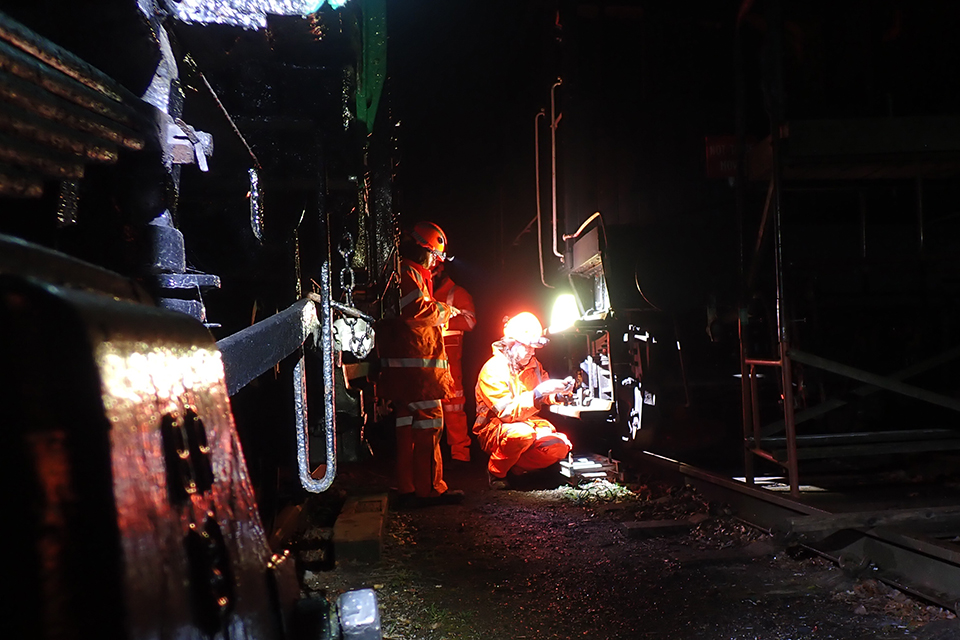
Over any year, many people and organisations assist RAIB in lots of ways, in circumstances that are sometimes difficult. I am very grateful for that. I would also like to thank my colleagues at the branch for their continued dedication and support.
Andrew Hall
Chief Inspector of Rail Accidents
May 2025
2. Operational activity
Our activities are governed by The Railways (Accident Investigation and Reporting) Regulations 2005 (the Regulations). The UK’s railway and tramway industries are required to report the types of accidents and incidents as set out in The Regulations.
In the operational year 1 January to 31 December 2024, we received 431 notifications. From these we undertook 56 preliminary examinations. Of these, 11 became full investigations with a further 12 resulting in us preparing safety digests to inform the industry. A further 8 preliminary examinations lead to us starting industry reviews, with 1 more being closed by writing to the Coroner. We also concluded that 24 preliminary examinations would lead to no further action.
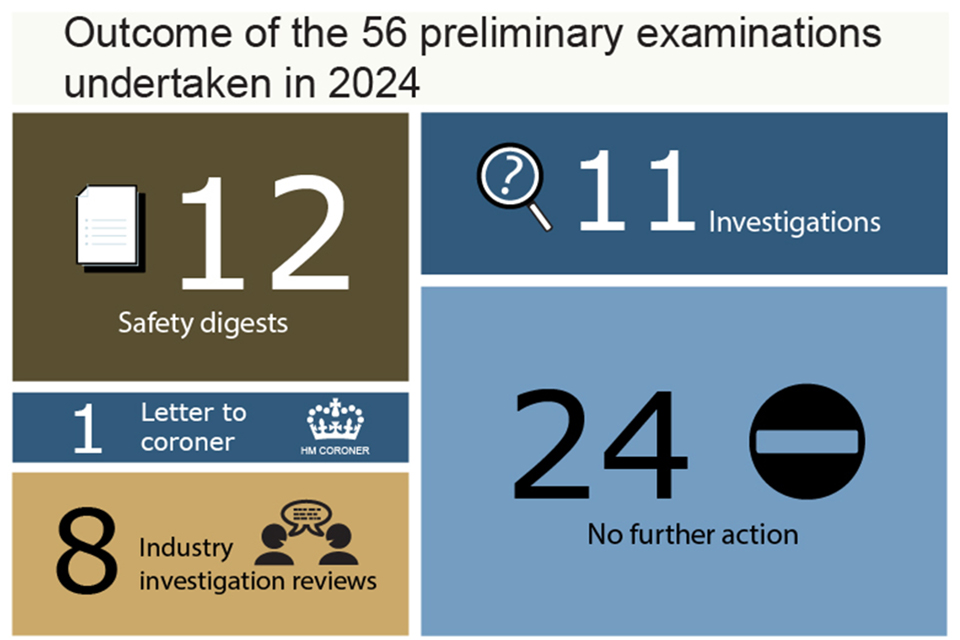
During the same period, we published 13 full investigations along with 10 Safety Digests, issued an Urgent Safety Advice to the industry, and wrote 3 letters to coroners.
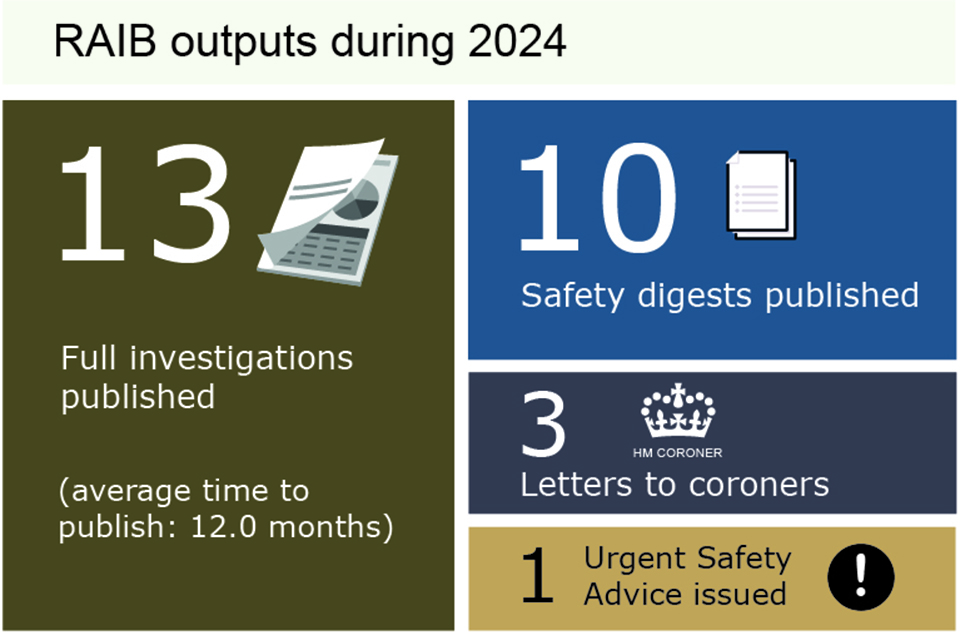
2.1 Accidents investigated by RAIB
RAIB has a duty to investigate all serious railway accidents as defined by the Regulations. These include derailments and collisions of rolling stock resulting in the death of one person, serious injuries to five or more people, or extensive damage to rolling stock, infrastructure or the environment.
We are also required to investigate incidents and accidents which, under slightly different circumstances, could have led to a serious accident, and which have an obvious impact on railway safety regulation or the management of safety.
We may investigate other notifiable railway accidents where an investigation will contribute to our mission to improve safety.
If the learning from an accident or incident is widely applicable, but we have published the learning previously or it is primarily about compliance, we may choose to produce a safety digest. This is shorter than a full investigation report and includes safety learning but not recommendations.
During the 5-year period 2020 to 2024, we started 104 full investigations and safety digests. Twenty involved railway employees and moving trains (such as accidents to track maintenance workers) and fifteen involved passengers and moving trains (such as a passenger trapped in train doors and dragged).
We also investigated fifteen unauthorised train movements, fourteen derailments (seven involved passenger trains and seven involved freight trains), ten collisions with obstacles and nine collisions with other trains. Nine involved harm, or the risk of harm, to people at level crossings, and seven were runaway incidents. Three involved failures of infrastructure and two involved train defects.
| Categories | Full investigations | Safety digests |
|---|---|---|
| Events involving moving trains (staff) (20) | 8 | 12 |
| SPADs or unauthorised train movements (15) | 9 | 6 |
| Events involving moving trains (passengers and members of public) (15) | 9 | 6 |
| Collisions with an obstacle (10) | 5 | 5 |
| Collisions with other trains (9) | 8 | 1 |
| Level crossing accidents and near misses (9) | 5 | 4 |
| Freight train derailments (7) | 7 | 0 |
| Runaway incidents (7) | 5 | 2 |
| Passenger train derailments (7) | 5 | 2 |
| Infrastructure failures (3) | 3 | 0 |
| Train defects (2) | 2 | 0 |
2.2 Northern Ireland and the Channel Tunnel
RAIB did not deploy to Northern Ireland in 2024, nor publish any reports relating to accidents there. However, RAIB has continued to liaise with Northern Ireland Railways (NIR) and the safety regulator, Department for Infrastructure (NI), on matters relating to accident investigation and safety learning.
There were no RAIB deployments to the Channel Tunnel or investigation activity related to it in 2024.
We continue to maintain good working relationships with our counterparts in the Republic of Ireland (Railway Accident Investigation Unit; RAIU), and France (the Bureau D’enquetes sur les Accidents de Transport Terreste; BEA-TT), and with the relevant infrastructure managers, railway undertakings, and safety authorities.
Memoranda of Co-operation (MoC) with RAIU and BEA-TT remain in place covering joint working in the event of a cross-border accident.
The regulatory regime in the Channel Tunnel is currently in transition. Regulatory supervision of the Channel Tunnel is undertaken by the Intergovernmental Commission (IGC) (for the UK part) and the Etablissement Public de Sécurité Ferroviaire (for the French part).
The UK and French governments are working together to agree a Technical Framework Agreement governing the safety and interoperability requirements for railway operations and rail accident investigation in the tunnel, as well as overall governance arrangements.
RAIB and BEA-TT have been party to these discussions and have agreed text for inclusion in the agreement, which will reflect the intent of both bodies to co-operate in the event of an accident or incident.
Once this agreement takes effect, ORR will assume the role of safety authority for the UK half of the tunnel. The IGC will continue to carry out its functions under the Treaty of Canterbury and the Fixed Link Concession Agreement.
3. Recommendations
RAIB makes recommendations to industry and other bodies with the aim of improving railway safety. The purpose of our recommendations is to reduce the chance of a similar accident occurring, or to reduce the consequences if such an event were to happen again.
When making recommendations, we identify organisations we consider best placed to implement the changes required. These organisations are known as ‘end implementers’. They include railway, non-railway, private, and public sector bodies.
The majority of our recommendations are addressed to the relevant safety authority. For UK railways this is ORR. In Northern Ireland it is the NI Department for Infrastructure (which is advised by the Health and Safety Executive NI). The safety authority for the UK part of the Channel Tunnel system is the Intergovernmental Commission until ORR takes on this role under the new Channel Tunnel Technical Framework agreement.
If a recommendation relates to an organisation not regulated by the railway industry’s safety authority it can be addressed to any other public body as required.
The law requires that the safety authority ensures end implementers consider our recommendations and act on them where required. The Regulations require end implementers to provide full details to the safety authority of the measures they intend to take, or have taken, to implement the recommendation.
The safety authority is required to consider each recommendation and action as appropriate. It should also inform us of any measures taken in response to the recommendation, or the reasons why no measures have been taken.
We collect information on actions taken in response to our recommendations. This information is generally based on reports we receive from the safety authority (usually ORR). Any public bodies which are the recipients of our recommendations are required to respond directly to us.
3.1 Current status of RAIB recommendations
We provide status updates for each recommendation in our . The index provides information as supplied to us by the relevant safety authority or public body. Each entry is linked to a recommendation status response that provides the full text of each recommendation.
As of 1 January 2023, ORR introduced new status definitions to replace those previously used. These responses to recommendations are now categorised as:
Open: Actions to address the recommendation are ongoing.
Closed: ORR consider the recommendation to have been taken into consideration by an end implementer and evidence provided to show action taken or justification for no action taken.
Insufficient response: The end implementer has not provided sufficient evidence that the recommendation has been taken into consideration, or if it has, the action proposed does not address the recommendation, or there is insufficient evidence to support no action being taken.
Superseded: The recommendation has been superseded either by a newer recommendation or actions have subsequently been taken by the end implementer that have superseded the recommendation.
Other recommendations not yet reported on are categorised as ‘Awaiting response’.
3.2 2024 recommendation distribution
In 2024, we made 41 recommendations with 41 end implementers. These included Network Rail, London Underground, passenger operators, light rail operators, freight train operators, central government and local government.
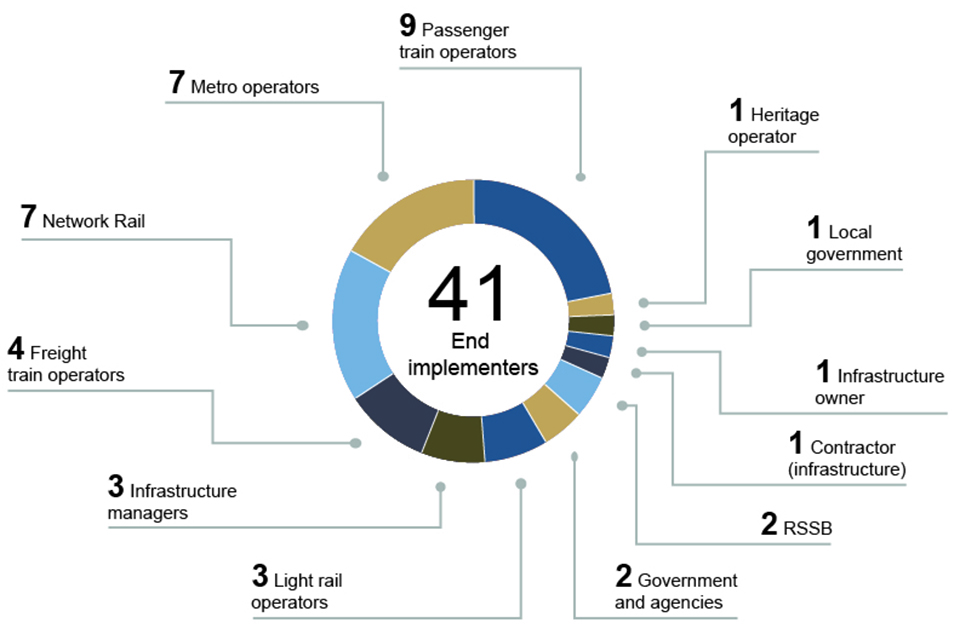
3.3 Recommendations
Between 2020 and 2024, we made a total of 249 recommendations. The status of these recommendations was:
- For 16.1 % of recommendations, the safety authority is yet to receive a response from the end implementer (‘awaiting response’).
- For 38.1 % of recommendations, actions to address the recommendation are ongoing (‘open’).
- For 44.6 % of recommendations, ORR consider the recommendation to have been taken into consideration by an end implementer and evidence provided to show action taken or justification for no action taken (‘closed’).
- For 1.2 % of recommendations, the relevant safety authority considers that the response received from an end implementer is insufficient (‘insufficient response’).
No recommendations have been reported as being superseded.
Status of recommendations by the year that they were made (as reported to RAIB by 31 December 2024):
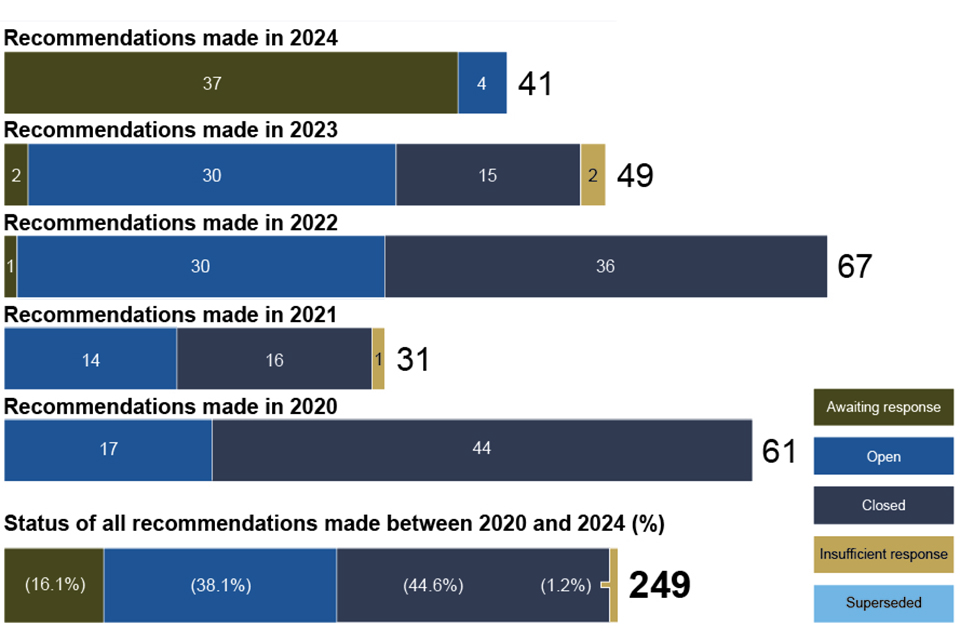
In the 5-year period from 2019 to 2023 (that is, those recommendations more than one year old on 31 December 2024) 61 % of them have been reported as closed.
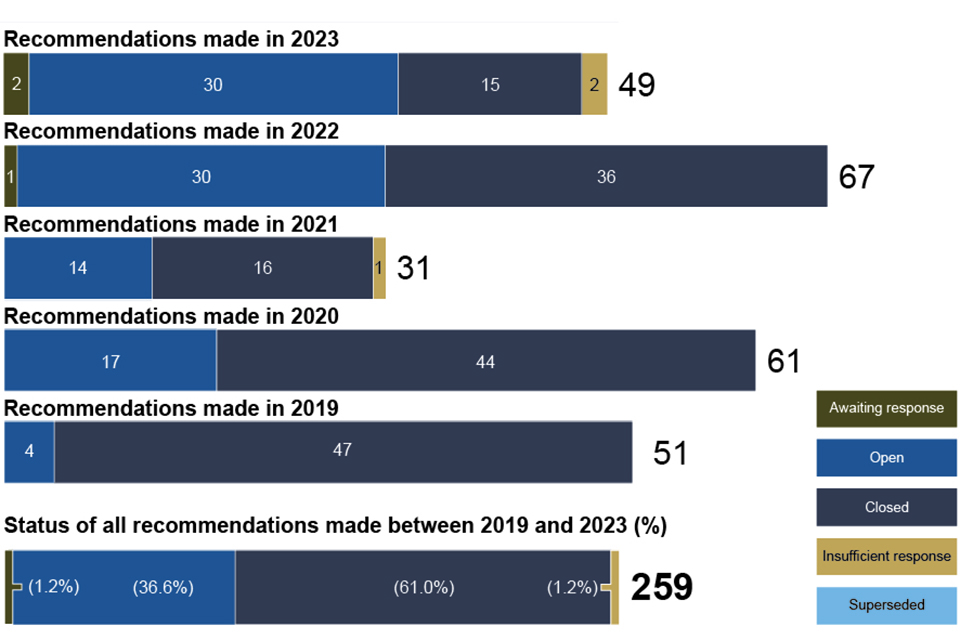
3.4 Areas of concern to RAIB
The safety authority, or public body to whom our recommendations are addressed, provides us with updates as to the status of the recommendation. Sometimes, after receiving this response, we may have concerns either about how the organisation has responded to the recommendation, or because of the information we receive from the safety authority.
When this happens, we will discuss our concerns with the safety authority or public body before recording any remaining concerns in the following year’s Annual Report.
When we record concerns regarding the actions taken in response to recommendations, we highlight them according to the following categorisation:
Red – we have concerns that no actions have been taken in response to a recommendation.
Blue – we are concerned that the actions taken are inappropriate or insufficient to address the risk identified during the investigation.
White – we note that substantive actions have been reported but we still have concerns about the underlying risk.
Concerns we have identified during 2024 are:
Report 01/2023 – Pedestrian struck by a train at Lady Howard footpath and bridleway crossing
Recommendation 1 – White
Intent of recommendation – The intent of this recommendation is to reduce the risk at footpath and bridleway level crossings of a second train approaching being hidden from the view of crossing users by a previously passing train.
ORR status – Closed
RAIB concern – ORR reported that Network Rail had taken substantive actions in response to this recommendation, with Network Rail proposing an interim solution that targets all relevant level crossings with improved signage, while continuing in the longer-term to fit miniature stop lights through normal risk management protocols.
Network Rail has stated that, while the likelihood of an event where a second train approaching is potentially hidden by another train can be influenced by factors such as the numbers of user and trains, other factors, such as topography and the type of crossing user, mean that it is too complex in practice to identify those crossings which have the highest risk of this occurring. As this makes prioritising mitigation for this risk alone challenging, Network Rail intends instead to manage it by the installation of signage at all crossings with two lines or more.
Network Rail has also stated that, while they continuously seek to improve their approach to level crossing safety, and to collaborate with other sectors and other railways internationally, there are at this point no further cost-effective technologies available which can be readily developed. Network Rail stated that they are committed to the continued rollout of existing technology, such as miniature stop lights, through normal risk management protocols, where they are demonstrated to manage risk so far as is reasonably practicable.
RAIB therefore remains concerned about the underlying risk which this recommendation sought to address.
Report 04/2023 – Near miss at Farnborough North footpath level crossing
Recommendation 1 – Blue
Intent of recommendation – The intent of this recommendation is to improve the control of risk at footpath level crossings where there is known to be a history of safety incidents, and where timescales to implement long-term safety improvements are uncertain.
ORR status – Closed
RAIB concern – ORR reported that Network Rail has reviewed its processes in response to this recommendation.
During its investigation into this incident, RAIB found that no detailed task analysis had been carried out at Farnborough North to determine how the crossing attendant would carry out their role and that the narrative risk assessments did not assess the residual risk or consider whether the mitigation arrangements continued to be fit for purpose.
Although Network Rail has reviewed its processes there is no indication of any changes having been made, despite the standards and guidance currently in place being unchanged since the incident.
RAIB is therefore concerned that the actions taken by Network Rail are inappropriate or insufficient to address the issues identified during the investigation.
Report 10/2023 – Freight train derailment at Petteril Bridge Junction
Recommendation 2 – Blue
Intent of recommendation – The intent of this recommendation is to understand and review the effectiveness and safety of the Rule Book requirement for freight train drivers to regularly look back along their train.
ORR status – Closed
RAIB concern – ORR has reported that the Rail Freight Operators Group (RFOG) has reviewed the effectiveness of the Rule Book requirement for a freight train driver to look back along a train to identify possible faults, such as a non-rotating wheelset.
RFOG concluded that the practice remains worthwhile, as a technological solution that would allow the same level of monitoring has not yet been developed, although a number of projects (such as the intelligent wagon programme) may mean this decision is revisited in future.
Although a review has been carried out, this has only considered the effectiveness of the requirement to look back along a train and not the additional safety risks that may be introduced by freight drivers having to regularly having to do this. This is despite the driver of the train involved considering that it was not safe to lean out of the cab window on the evening of the accident.
RAIB is therefore concerned that the actions taken by RFOG are insufficient to address the issues identified during the investigation.
4. Summaries of learning
Our investigations have allowed us to gather detailed insights into a range of accidents and their associated causal factors. Using this information, we have identified recurring themes and have shared this information with the industry in the form of summaries of learning documents since launching them in 2019. We regularly review these themes and will update them based on our latest investigations.
The current themes we have identified are:
1 - Design and operation of user worked level crossings
2 - Protection of track workers from moving trains
3 - Managing risk at the platform-train interface
4 - Safe management of abnormal train-operating events
6 - Safe design, operation and maintenance of on-track plant and trolleys
7 - The safe management of weather-related events which affect train operation
8 - The integrity of train braking systems
9 - Wrong side failures of signalling
10 - Management assurance
You can read each of the summaries of learning at: /government/collections/summaries-of-learning
5. Safety and funding
5.1 RAIB’s own safety record
We work hard to ensure we have the highest standards for health, safety, and wellbeing in all aspects of our operations. We review our work and apply any lessons learned from attending site to improve our safety management. We regularly review our office practice and update our health and safety governance arrangements, incorporating learning from accidents and incidents. Two minor accidents were recorded involving our staff in 2024.
As part of this aim to improve, we work closely with external partners, particularly the Air and Marine Accident Investigation Branches. Sharing common lessons learnt and best practice across work areas such as health, safety and wellbeing helps keep both our own team, as well as those we work with, as safe as possible.
5.2 Funding
Our operating budget for the 2023 - 2024 financial year was around £5.5 million.
6. Other activities
6.1 External events
Throughout 2024, we were able to participate in a variety of external events, either in person or virtually. Such participation permits us to reach other areas of the industry and allows us to fulfil our aim of informing the industry and public.
Some of the topics we spoke about included: how RAIB operates, track engineering, earthworks and drainage, and human factors. The events were hosted at a variety of professional institutions, universities, and rail interest groups.
You can find out more about previous presentations we’ve made at: /government/publications/raib-papers-and-presentations
6.2 Working with academia
Building relationships with universities specialising in subjects relevant to our investigations helps ensure we keep up to date with the latest thinking in accident investigation techniques and cutting-edge research in relevant technical specialisms. Universities benefit by being exposed to current trends and intractable problems prevalent in the industry that can form the basis for research projects, and by having input to taught courses through student supervision and specialist lectures. RAIB has worked collaboratively with the University of Sheffield to deliver training on low adhesion, and at University of Cranfield delivering lectures on the use of electronic data within investigations.
6.3 Rail accident investigators’ good practice seminar
The 6th Railway Accident Investigators’ Seminar was held in Birmingham in November 2024.
We welcomed guest speakers from Network Rail, Cranfield University, Arriva Rail London and Transport for London, along with presentations from our own inspectors. Topics included evidence photography, using causal analysis techniques, fatigue, investigating overspeeding, and using testing and reconstruction.
Feedback from these events shows us they are well received by industry colleagues with an investigative role, and plans are in place for developing the 2025 event which also coincides with our own 20th anniversary of operations.
6.4 The Accident Investigation Chiefs’ Council
The Accident Investigation Chiefs’ Council (AICC) comprises a non-executive chair and the Chief Inspectors from the Air, Marine and Rail Accident Investigation Branches.
AICC aims to enhance co-operation between the Air, Marine and Rail Accident Investigation Branches. It seeks to achieve this through encouraging collaborative working practices and promoting effective working arrangements with external bodies to improve RAIB’s effectiveness and efficiency.
Find out more about the role of AICC and its terms of reference at: 51²è¹Ý and search AICC.
6.5 International relations
RAIB has been a longstanding member of the International Transportation Safety Association (ITSA). ITSA is an international network of heads of independent safety investigation bodies, covering all modes of transport, including aviation, marine, railways, road transport, pipelines, and underground infrastructure. It has established a Railway Accident Investigators International Forum of which we are also a member. ITSA membership includes major investigation bodies across five continents, such as the NTSB in the USA and the ATSB in Australia.
We maintain mutually beneficial relationships with the EU National Investigation Bodies and attend their plenary meetings and sit on three subject specific task groups in an advisory capacity.
As in other years, RAIB received a number of requests for advice or assistance from investigation bodies around the world and, if resource allowed, provided it.
7. Table of investigations started, ongoing and published 2024
(Items prefixed with the letter ‘SD’ are safety digests, the remainder are full investigations)
| Event (National Network Ìý unless stated otherwise) | Event date | Published | Occurrence type |
|---|---|---|---|
| Buffer stop collision at London Bridge station | 13/12/2024 | n/a | Collision with an obstacle |
| SD - Near miss with track workers at Morton Junction | 27/11/2024 | 01/04/2025 | Train movement event involving staff |
| Trap and drag accident at Ealing Broadway | 24/11/2024 | n/a | Train movement event involving passengers / pedestrians |
| Collision between passenger trains near Talerddig | 21/10/2024 | n/a | Collision between trains |
| SD - Overspeeding near Manor Park) | 24/09/2024 | 27/01/2025 | SPAD or unauthorised train movement |
| Derailment of a freight train at Audenshaw | 06/09/2024 | n/a | Freight train derailment |
| SD - Near miss between a train and heavy goods vehicle near Craven Arms | 22/07/2024 | 18/09/2024 | Near miss – Level crossing |
| SD - Passenger trapped in doors and dragged at Enfield Town station | 17/07/2024 | 08/10/2024 | Train movement event involving passengers / pedestrians |
| SD - Contact between a moving train and an occupied pram at Banbury station | 08/06/2024 | 07/11/2024 | Train movement event involving passengers / pedestrians |
| Runaway of a trolley and subsequent collision at North Rode | 26/05/2024 | 01/05/2025 | Runaway incident |
| Passenger train collision with a road vehicle at Redcar level crossing | 01/05/2024 | 03/04/2025 | Level crossing event |
| SD - Collision between a train and an object left on the track at Kings Langley | 25/04/2024 | 24/07/2024 | Collision with an obstacle |
| Track worker near miss at Chiltern Green | 23/04/2024 | 17/04/2025 | Train movement event involving staff |
| Derailment of a passenger train at Grange-over-Sands | 22/03/2024 | 28/01/2025 | Passenger train derailment |
| SD - Near miss with track worker at Euxton Junction | 14/03/2024 | 19/06/2024 | Train movement event involving staff |
| SD - Near miss with a track worker, Littlehempston | 13/03/2024 | 13/08/2024 | Train movement event involving staff |
| Derailment of a passenger train near Walton-on-Thames | 04/03/2024 | 17/02/2025 | Passenger train derailment |
| Derailment of a passenger train at Roudham Heath | 06/02/2024 | 03/02/2025 | Passenger train derailment |
| SD - Track worker struck by a road-rail vehicle at Braybrooke) | 06/02/2024 | 29/05/2024 | Train movement event involving staff |
| SD - Near miss with a track worker near Fishguard | 04/01/2024 | 10/04/2024 | Train movement event involving staff |
| SD - Near miss near Nottingham station | 01/01/2024 | 24/04/2024 | Train movement event involving staff |
| Collision between a passenger train and a fallen tree at Broughty Ferry | 27/12/2023 | 23/12/2024 | Collision with an obstacle |
| Fatal accident at Stratford London Underground station | 26/12/2023 | 16/01/2025 | Train movement event involving passengers / pedestrians |
| SD - Train damaged by collision with an object at Highdyke Junction | 19/12/2023 | 17/04/2024 | Collision with an obstacle |
| Collision between a road-rail vehicle and a trolley​ near Brading | 22/11/2023 | 24/10/2024 | Runaway incident |
| Collision between on-track machines near to Strood | 16/11/2023 | 24/10/2024 | Collision between trains |
| Collision at Aviemore station on the Strathspey Railway | 29/09/2023 | 05/09/2024 | Collision between trains |
| Member of staff struck by a train at St Philips Marsh depot | 26/09/2023 | 11/07/2024 | Train movement event involving staff |
| Signal passed at danger at Stafford Trent Valley Junction No. 1 | 22/08/2023 | 17/06/2024 | SPAD or unauthorised train movement |
| Derailment of a tram at Bulwell | 12/06/2023 | 27/03/2024 | Passenger train derailment |
| Runaway wagon at Kineton | 25/05/2023 | 16/05/2024 | SPAD or unauthorised train movement |
| Uncontrolled evacuation of a partially platformed train at Clapham Common London Underground station | 05/05/2023 | 08/05/2024 | Train movement event involving passengers / pedestrians |
| Overspeed at Spital Junction | 04/05/2023 | 16/09/2024 | SPAD or unauthorised train movement |
| Unsafe movement of a train at Styal station | 03/05/2023 | 01/07/2024 | Train defects |
| Trap and drag accidents at Archway and Chalk Farm stations | 18/02 & 20/04/2023 | 27/06/2024 | Train movement event involving passengers / pedestrians |
| Train striking debris at Yarnton | 10/02/2023 | 01/02/2024 | Infrastructure failure |
8. Response to RAIB recommendations made in the Carmont investigation
Since the end of 2024, progress has been reported by the industry and ORR has updated its assessment of the status of actions taken in response to RAIB’s recommendations on the Carmont investigation. Shown below is a summary table showing the status of recommendations based on information provided by ORR up to 31 March 2025.
| Status [footnote 1] | Explanation |
|---|---|
| Open (O) | ORR reports that the end implementer(s) has/have taken the recommendation into consideration and is/are taking action to implement it. |
| Closed (C) | ORR reports that the end implementer(s) has/have taken the recommendation into consideration and has/have taken action to implement it. |
| Rec. | Subject | End implementer(s) |
|---|---|---|
| 1 | Contract and project management | Network Rail (C) |
| 2 | New works and maintenance processes | Network Rail (O) |
| 3 | Drainage design | Network Rail (O) |
| 4 | Mixed cutting examinations | Network Rail / Amey (C) [footnote 2] |
| 5 | Reporting incomplete examinations | Network Rail (C) |
| 6 | Mitigating rainfall-related threats | Network Rail (C) |
| 7 | Control room capability | Network Rail (O) |
| 8 | Management assurance of control room functions | Network Rail (O) |
| 9 | Learning from previous events | Network Rail (C) |
| 10 | Risk assessment of mitigating controls | Network Rail (O) |
| 11 | Route proving trains | Network Rail (C) |
| 12 | Derailment mitigation | Network Rail / RDG (O) |
| 13 | Infrastructure-mounted derailment containment | Network Rail (C) |
| 14 | Lifeguards | HST owners (C) [footnote 3] |
| 15 | Glazing | RSSB (C) |
| 16 | Folding tables | Angel Trains (C) [footnote 3] |
| 17 | Secondary impact protection for drivers | RSSB (C) |
| 18 | Corrosion limits | Owners of MkIII stock (O) [footnote 3] |
| 19 | Pre-1994 crashworthiness | Operators of HSTs (O) [footnote 3] |
| 20 | Fire properties of batteries | RSSB (C) |
-
Effective from 1 January 2023, ORR introduced four new statuses to replace the eight previously used. These are: ‘Open’, ‘Closed’, ‘Insufficient response’ and ‘Superseded’See section 3.1.ÌýÌý↩
-
ORR has accepted Network Rail’s justification for not involving Amey in this recommendation.Ìý↩
-
Recommendations 14, 16, 18 and 19 are being taken forward by RSSB on behalf of the industry.Ìý↩Ìý↩2Ìý↩3Ìý↩4
